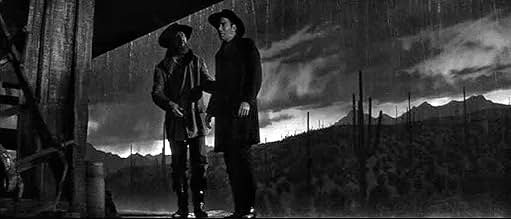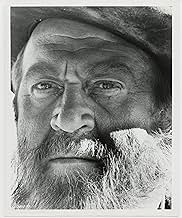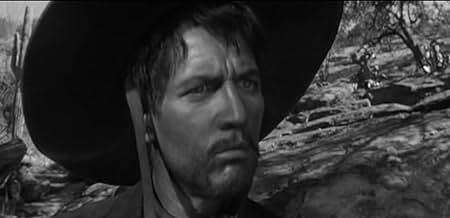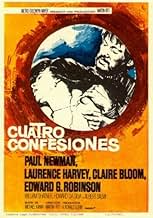IMDb-BEWERTUNG
6,2/10
2590
IHRE BEWERTUNG
Füge eine Handlung in deiner Sprache hinzuTravelers in the 1870s Southwest discuss a recent murder trial in which all the principals told differing stories about the events.Travelers in the 1870s Southwest discuss a recent murder trial in which all the principals told differing stories about the events.Travelers in the 1870s Southwest discuss a recent murder trial in which all the principals told differing stories about the events.
Handlung
WUSSTEST DU SCHON:
- WissenswertesPaul Newman was concerned about his accent, so he spent two weeks in Mexico with dialect coach Walon Green.
- PatzerWhen the Wife (Bloom) is fighting Juan (Newman), she falls and hits the camera rig, causing the picture to shake a little.
- Crazy CreditsExcept for the title and company name, the beginning of the movie has no opening credits.
- VerbindungenFeatured in MGM 40th Anniversary (1964)
Ausgewählte Rezension
"The Outrage" is a re-make of the Akira Kurosawa classic "Rashomon." It's a very faithful adaptation but does not improve upon the original. It would have been better served not to have been as faithful as it was. The cinematography of "Rashomon," for instance, is groundbreaking and an all-time great. Martin Ritt's remake is slicker and more modern but not better. "Outrage" is set in the old west, where the original was set in feudal Japan. Four years before "Outrage," director John Sturges remade Kurosawa's `Seven Samurai' into "The Magnificent Seven." Both are classics. Ritt's stab at Kurosawa (a slightly older film) has been swept up into the sands of film history and is little-remembered. This despite an all-star cast that includes Edward G. Robinson, Laurence Harvey, William Shatner, and Paul Newman as (agh!) a Mexican outlaw.
The source material for "Magnificent Seven" is a story and a script written for film. The source material for "Outrage" technically is a short story written in the early 20th century by Ryunosuke Akutagawa called "In A Grove," from which "Rashomon" was also adapted. Oddly, `Rashomon' is another story altogether, by the same author. The Rashomon Gate is the largest entrance to the walled, then-capital of Japan, Kyoto. Having chosen this the setting for the telling of the film's story, as the three souls take refuge from a storm under this giant gate, Kurosawa re-named the film after it. Instead of going back to the original source, Ritt remakes Kurosawa's film. In doing so, Ritt walks into a trap many filmmakers do when trying to faithfully remake a much-loved piece of work. To remake a film seems to convey that the original lacked something or was somehow flawed. "Rashomon" clearly did not need to be re-made. But once the decision was made to make another version, whether Ritt used the film or the Akutagawa story as his source, it's a no-win situation. Even if he'd based it on the original story, he would have spent his time and energy trying NOT to make another version of "Rashomon."
There are humorous moments in both films. More times than not, I could not tell the difference between what was funny intentionally or unintentionally in "Outrage." One possible improvement that is made by the remake is that the fourth and final re-telling of the trial by the thief, distinguishes itself much more from the first telling, by the bandit. It comes off more comically, which I believe was intended in Kurosawa's version, but doesn't quite come across. The sequence, taken by itself, is the high point of "Outrage."
All things considered, "The Outrage" is an exercise in futility. It's a curiosity for those wondering how yet another Kurosawa film could be overhauled and made into a western. I'd guess the idea was to bring the same story to America, with a more familiar setting, in English. Maybe someday directors will quit wasting their time trying to re-make films that are already masterpieces. If you really feel you need to do a re-make, find a bad film and rise to the challenge of improving upon it (example: Christopher Nolan's "Insomnia"). With "Rashomon," there was nowhere to go but down.
The one exception is the aforementioned "Magnificent Seven." By Kurosawa's own admission, the inspiration for his "Seven Samurai" came from the American western genre. It's for this reason that Sturges' remake works so well.
The source material for "Magnificent Seven" is a story and a script written for film. The source material for "Outrage" technically is a short story written in the early 20th century by Ryunosuke Akutagawa called "In A Grove," from which "Rashomon" was also adapted. Oddly, `Rashomon' is another story altogether, by the same author. The Rashomon Gate is the largest entrance to the walled, then-capital of Japan, Kyoto. Having chosen this the setting for the telling of the film's story, as the three souls take refuge from a storm under this giant gate, Kurosawa re-named the film after it. Instead of going back to the original source, Ritt remakes Kurosawa's film. In doing so, Ritt walks into a trap many filmmakers do when trying to faithfully remake a much-loved piece of work. To remake a film seems to convey that the original lacked something or was somehow flawed. "Rashomon" clearly did not need to be re-made. But once the decision was made to make another version, whether Ritt used the film or the Akutagawa story as his source, it's a no-win situation. Even if he'd based it on the original story, he would have spent his time and energy trying NOT to make another version of "Rashomon."
There are humorous moments in both films. More times than not, I could not tell the difference between what was funny intentionally or unintentionally in "Outrage." One possible improvement that is made by the remake is that the fourth and final re-telling of the trial by the thief, distinguishes itself much more from the first telling, by the bandit. It comes off more comically, which I believe was intended in Kurosawa's version, but doesn't quite come across. The sequence, taken by itself, is the high point of "Outrage."
All things considered, "The Outrage" is an exercise in futility. It's a curiosity for those wondering how yet another Kurosawa film could be overhauled and made into a western. I'd guess the idea was to bring the same story to America, with a more familiar setting, in English. Maybe someday directors will quit wasting their time trying to re-make films that are already masterpieces. If you really feel you need to do a re-make, find a bad film and rise to the challenge of improving upon it (example: Christopher Nolan's "Insomnia"). With "Rashomon," there was nowhere to go but down.
The one exception is the aforementioned "Magnificent Seven." By Kurosawa's own admission, the inspiration for his "Seven Samurai" came from the American western genre. It's for this reason that Sturges' remake works so well.
- RolloTomasi
- 13. Mai 2003
- Permalink
Top-Auswahl
Melde dich zum Bewerten an und greife auf die Watchlist für personalisierte Empfehlungen zu.
- How long is The Outrage?Powered by Alexa
Details
Box Office
- Budget
- 3.000.000 $ (geschätzt)
- Laufzeit1 Stunde 36 Minuten
- Farbe
- Seitenverhältnis
- 2.39 : 1
Zu dieser Seite beitragen
Bearbeitung vorschlagen oder fehlenden Inhalt hinzufügen

Oberste Lücke
By what name was Carrasco, der Schänder (1964) officially released in India in English?
Antwort




























